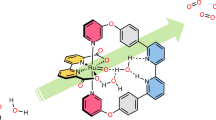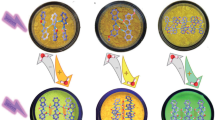Abstract
Using water as a hydrogen or oxygen source in organic synthesis has enabled various reductive and oxidative transformations, but incorporation of both hydrogen and oxygen atoms into the same molecule, representing an atom-economic and environmentally benign process, has scarcely been explored. Here we report a hydrogenative oxidation strategy using water as both a source of H2 and formal oxidant, enabling the direct synthesis of lactams from N-heteroarenes and thereby eliminating the need for additional reductants and oxidants and minimizing waste generation. The reaction can be initiated either under low H2 pressure or with a catalytic amount of H2, leading to the efficient transformation of various N-heteroarenes into lactams in excellent yield thanks to an in situ-generated, piperidine-based, ruthenium pincer complex that balances the hydrogenation and dehydrogenation processes. This study will promote the design of other hydrogenative oxidation reactions using water.

This is a preview of subscription content, access via your institution
Access options
Access Nature and 54 other Nature Portfolio journals
Get Nature+, our best-value online-access subscription
$32.99 / 30 days
cancel any time
Subscribe to this journal
Receive 12 digital issues and online access to articles
$119.00 per year
only $9.92 per issue
Buy this article
- Purchase on SpringerLink
- Instant access to full article PDF
Prices may be subject to local taxes which are calculated during checkout





Similar content being viewed by others
Data availability
Crystallographic data for the structures reported in this Article have been deposited at the Cambridge Crystallographic Data Centre, under deposition numbers CCDC 2348166 (Ru-9) and CCDC 2348165 (Ru-10). Copies of the data can be obtained free of charge via https://www.ccdc.cam.ac.uk/structures/. Data are available from the corresponding author on request.
References
Bryant, D. A. & Frigaard, N. U. Prokaryotic photosynthesis and phototrophy illuminated. Trends Microbiol. 14, 488–496 (2006).
Sligar, S. G., Marks, T. M. & Denisov, I. G. Thirty years of microbial P450 monoxygenase research: peroxo-heme intermediates—the central bus station in heme oxygenase catalysis. Biochem. Biophys. Res. Commun. 338, 346–354 (2005).
Liu, C., Wu, Y., Zhao, B. & Zhang, B. Designed nanomaterials for electrocatalytic organic hydrogenation using water as the hydrogen source. Acc. Chem. Res. 56, 1872–1883 (2023).
Zhao, E., Zhang, W., Dong, L., Zbořil, R. & Chen, Z. Photocatalytic transfer hydrogenation reactions using water as the proton source. ACS Catal. 13, 7557–7567 (2023).
Crabtree, R. H. Homogeneous transition metal catalysis of acceptorless dehydrogenative alcohol oxidation: applications in hydrogen storage and to heterocycle synthesis. Chem. Rev. 117, 9228–9246 (2017).
Kar, S. & Milstein, D. Oxidation of organic compounds using water as the oxidant with H2 liberation catalyzed by molecular metal complexes. Acc. Chem. Res. 55, 2304–2315 (2022).
Cummings, S. P., Le, T.-N., Fernandez, G. E., Quiambao, L. G. & Stokes, B. J. Tetrahydroxydiboron-mediated palladium-catalyzed transfer hydrogenation and deuteriation of alkenes and alkynes using water as the stoichiometric H or D atom donor. J. Am. Chem. Soc. 138, 6107–6110 (2016).
Zhang, J., Mück-Lichtenfeld, C. & Studer, A. Photocatalytic phosphine-mediated water activation for radical hydrogenation. Nature 619, 506–513 (2023).
Kurimoto, A., Sherbo, R. S., Cao, Y., Loo, N. W. X. & Berlinguette, C. P. Electrolytic deuteration of unsaturated bonds without using D2. Nat. Catal. 3, 719–726 (2020).
Liu, X., Liu, R., Qiu, J., Cheng, X. & Li, G. Chemical-reductant-free electrochemical deuteration reaction using deuterium oxide. Angew. Chem. Int. Ed. 59, 13962–13967 (2020).
Wu, Y., Liu, C., Wang, C., Lu, S. & Zhang, B. Selective transfer semihydrogenation of alkynes with H2O (D2O) as the H (D) source over a Pd–P cathode. Angew. Chem. Int. Ed. 59, 21170–21175 (2020).
Balaraman, E., Khaskin, E., Leitus, G. & Milstein, D. Catalytic transformation of alcohols to carboxylic acid salts and H2 using water as the oxygen atom source. Nat. Chem. 5, 122–125 (2013).
Nielsen, M. et al. Low-temperature aqueous-phase methanol dehydrogenation to hydrogen and carbon dioxide. Nature 495, 85–89 (2013).
Cha, H. G. & Choi, K.-S. Combined biomass valorization and hydrogen production in a photoelectrochemical cell. Nat. Chem. 7, 328–333 (2015).
Liang, Y. et al. Electrochemically induced nickel catalysis for oxygenation reactions with water. Nat. Catal. 4, 719–726 (2021).
Yan, Y., Zhong, J., Wang, R., Yan, S. & Zou, Z. Trivalent nickel-catalyzing electroconversion of alcohols to carboxylic acids. J. Am. Chem. Soc. 146, 4814–4821 (2024).
Simonetti, S. O., Larghi, E. L. & Kaufman, T. S. The 3,4-dioxygenated 5-hydroxy-4-aryl-quinolin-2(1H)-one alkaloids. Results of 20 years of research, uncovering a new family of natural products. Nat. Prod. Rep. 33, 1425–1446 (2016).
Chen, X. et al. Structure–functional selectivity relationship studies of β-arrestin-biased dopamine D2 receptor agonists. J. Med. Chem. 55, 7141–7153 (2012).
Cavusoglu, E., Frishman, W. H. & Klapholz, M. Vesnarinone: a new inotropic agent for treating congestive heart failure. J. Card. Fail. 1, 249–257 (1995).
Lucas, S. et al. In vivo active aldosterone synthase inhibitors with improved selectivity: lead optimization providing a series of pyridine substituted 3,4-dihydro-1H-quinolin-2-one derivatives. J. Med. Chem. 51, 8077–8087 (2008).
Bello, R. D. et al. 1-[3-(4-Butylpiperidin-1-yl)propyl]-1,2,3,4-tetrahydroquinolin-2-one (77-LH-28-1) as a model for the rational design of a novel class of brain penetrant ligands with high affinity and selectivity for dopamine D4 receptor. J. Med. Chem. 61, 3712–3725 (2018).
Mackenzie, A. R., Marchington, A. P., Middleton, D. S., Newman, S. D. & Jones, B. C. Structure–activity relationships of 1-alkyl-5-(3,4-dichlorophenyl)-5-{2-[(3-substituted)-1-azetidinyl]ethyl}-2-piperidones. 1. Selective antagonists of the neurokinin-2 receptor. J. Med. Chem. 45, 5365–5377 (2002).
Hong, S. Y. et al. Selective formation of γ-lactams via C–H amidation enabled by tailored iridium catalysts. Science 359, 1016–1021 (2018).
Li, B., Park, Y. & Chang, S. Regiodivergent access to five- and six-membered benzo-fused lactams: Ru-catalyzed olefin hydrocarbamoylation. J. Am. Chem. Soc. 136, 1125–1131 (2014).
Wang, M. D. & Alper, H. Regioselective synthesis of piperidinones by metal catalyzed ring expansion–carbonylation reactions. Remarkable cobalt and/or ruthenium carbonyl catalyzed rearrangement and cyclization reactions. J. Am. Chem. Soc. 114, 7018–7024 (1992).
Zhang, Z. et al. Lactamization of sp2 C–H bonds with CO2: transition metal-free and redox-neutral. Angew. Chem. Int. Ed. 55, 7068–7072 (2016).
Mazumdar, W., Jana, N., Thurman, B. T., Wink, D. J. & Driver, T. G. Rh2(II)-catalyzed ring expansion of cyclobutanol-substituted aryl azides to access medium-sized N-heterocycles. J. Am. Chem. Soc. 139, 5031–5034 (2017).
Ye, Y. et al. Using enzymes to tame nitrogen-centred radicals for enantioselective hydroamination. Nat. Chem. 15, 206–212 (2023).
Du, Y.-D. et al. Organophotocatalysed synthesis of 2-piperidinones in one step via [1 + 2 + 3] strategy. Nat. Commun. 14, 5339 (2023).
Moor, L. F. E., Vasconcelos, T. R. A., Reis, R. d. R., Pinto, L. S. S. & da Costa, T. M. Quinoline: an attractive scaffold in drug design. Mini Rev. Med. Chem. 21, 2209–2226 (2021).
Bunz, U. H. F. & Freudenberg, J. N-heteroacenes and N-heteroarenes as N-nanocarbon segments. Acc. Chem. Res. 52, 1575–1587 (2019).
El-Shahat, M. Advances in the reduction of quinolines to 1,2,3,4-tetrahydroquinolines. J. Heterocycl. Chem. 59, 399–421 (2022).
Xie, L.-Y. et al. Fast, base-free and aqueous synthesis of quinolin-2(1H)-ones under ambient conditions. ACS Sustain. Chem. Eng. 5, 10407–10412 (2017).
Tanaka, N. & Usuki, T. Can heteroarenes/arenes be hydrogenated over catalytic Pd/C under ambient conditions? Eur. J. Org. Chem. 2020, 5514–5522 (2020).
Wagener, T., Lückemeier, L., Daniliuc, C. G. & Glorius, F. Interrupted pyridine hydrogenation: asymmetric synthesis of δ-lactams. Angew. Chem. Int. Ed. 60, 6425–6429 (2021).
Dobereiner, G. E. et al. Iridium-catalyzed hydrogenation of N-heterocyclic compounds under mild conditions by an outer-sphere pathway. J. Am. Chem. Soc. 133, 7547–7562 (2011).
Papa, V., Cao, Y., Spannenberg, A., Junge, K. & Beller, M. Development of a practical non-noble metal catalyst for hydrogenation of N-heteroarenes. Nat. Catal. 3, 135–142 (2020).
Wang, Y. et al. Unmasking the ligand effect in manganese-catalyzed hydrogenation: mechanistic insight and catalytic application. J. Am. Chem. Soc. 141, 17337–17349 (2019).
Adam, R. et al. A general and highly selective cobalt-catalyzed hydrogenation of N-heteroarenes under mild reaction conditions. Angew. Chem. Int. Ed. 56, 3216–3220 (2017).
Nagaraaj, P. & Vijayakumar, V. Oxidation of amine α-carbon to amide: a review on direct methods to access the amide functionality. Org. Chem. Front. 6, 2570–2599 (2019).
Freifelder, M. & Stone, G. R. Reductions with ruthenium. II. Its use in the hydrogenation of pyridines. J. Org. Chem. 26, 3805–3808 (1961).
Freifelder, M. Hydrogenation in the pyridine series. I. Catalytic reduction of the isomeric acetylpyridines. J. Org. Chem. 29, 2895–2898 (1964).
Sowmiah, S., Esperança, J. M. S. S., Rebelo, L. P. N. & Afonso, C. A. M. Pyridinium salts: from synthesis to reactivity and applications. Org. Chem. Front. 5, 453–493 (2018).
Wu, J. et al. Synthesis of chiral piperidines from pyridinium salts via rhodium-catalysed transfer hydrogenation. Nat. Catal. 5, 982–992 (2022).
Wen, X., Wang, S.-B., Liu, D.-C., Gong, G.-H. & Quan, Z.-S. Synthesis and evaluation of the anti-inflammatory activity of quinoline derivatives. Med. Chem. Res. 24, 2591–2603 (2015).
Quan, Z.-S. et al. Synthesis of 6-alkyloxyl-3,4-dihydro-2(1H)-quinoliones and their anticonvulsant activities. Bull. Korean Chem. Soc. 26, 1757–1760 (2005).
Luo, L. et al. ATP-competitive inhibitors of the mitotic kinesin KSP that function via an allosteric mechanism. Nat. Chem. Biol. 3, 722–726 (2007).
Duffy, B. C. et al. Discovery of a new chemical series of BRD4(1) inhibitors using protein-ligand docking and structure-guided design. Bioorg. Med. Chem. Lett. 25, 2818–2823 (2015).
Khaskin, E. & Milstein, D. Simple and efficient catalytic reaction for the selective deuteration of alcohols. ACS Catal. 3, 448–452 (2013).
Dawe, L. N., Karimzadeh-Younjali, M., Dai, Z., Khaskin, E. & Gusev, D. G. The Milstein bipyridyl PNN pincer complex of ruthenium becomes a Noyori-type catalyst under reducing conditions. J. Am. Chem. Soc. 142, 19510–19522 (2020).
Zeng, G. & Li, S. Insights into dehydrogenative coupling of alcohols and amines catalyzed by a (PNN)Ru(II) hydride complex: unusual metal–ligand cooperation. Inorg. Chem. 50, 10572–10580 (2011).
Li, H. et al. Computational study on the catalytic role of pincer ruthenium(II)-PNN complex in directly synthesizing amide from alcohol and amine: the origin of selectivity of amide over ester and imine. Organometallics 30, 5233–5247 (2011).
Li, H. & Hall, M. B. Mechanism of the formation of carboxylate from alcohols and water catalyzed by a bipyridine-based ruthenium complex: a computational study. J. Am. Chem. Soc. 136, 383–395 (2014).
Wei, Z., Li, H., Wang, Y. & Liu, Q. A tailored versatile and efficient NHC-based NNC-pincer manganese catalyst for hydrogenation of polar unsaturated compounds. Angew. Chem. Int. Ed. 62, e202301042 (2023).
Acknowledgements
We thank I. Efremenko for her valuable assistance with the computational work. C.Y. thanks the Sustainability and Energy Research Initiative-Weizmann Institute of Science for a research fellowship.
Author information
Authors and Affiliations
Contributions
D.M., Y.L. and J.L. conceived and directed the project and designed the experiments. Y.L. and J.L. performed and analysed the experiments. C.Y. performed selected experiments and provided insightful discussions. Y.D.-P. analysed crystals. All authors were involved in paper preparation.
Corresponding author
Ethics declarations
Competing interests
The authors declare no competing interests.
Peer review
Peer review information
Nature Catalysis thanks David Morales-Morales, Jianliang Xiao and the other, anonymous, reviewer(s) for their contribution to the peer review of this work.
Additional information
Publisher’s note Springer Nature remains neutral with regard to jurisdictional claims in published maps and institutional affiliations.
Supplementary information
Supplementary Information
Supplementary Notes 1–13, Tables 1–6, Figs. 1–118, methods and references.
Supplementary Data 1
Coordinates for the calculated structures.
Supplementary Data 2
Crystallographic information file for Ru-9.
Supplementary Data 3
Crystallographic information file for Ru-10.
Rights and permissions
Springer Nature or its licensor (e.g. a society or other partner) holds exclusive rights to this article under a publishing agreement with the author(s) or other rightsholder(s); author self-archiving of the accepted manuscript version of this article is solely governed by the terms of such publishing agreement and applicable law.
About this article
Cite this article
Liang, Y., Luo, J., You, C. et al. A hydrogenative oxidation strategy for the single-step synthesis of lactams from N-heteroarenes using water. Nat Catal 8, 98–106 (2025). https://doi.org/10.1038/s41929-024-01286-2
Received:
Accepted:
Published:
Issue date:
DOI: https://doi.org/10.1038/s41929-024-01286-2
This article is cited by
-
Neither H2 nor O2 in hydrogenative oxidations with water
Nature Catalysis (2025)



